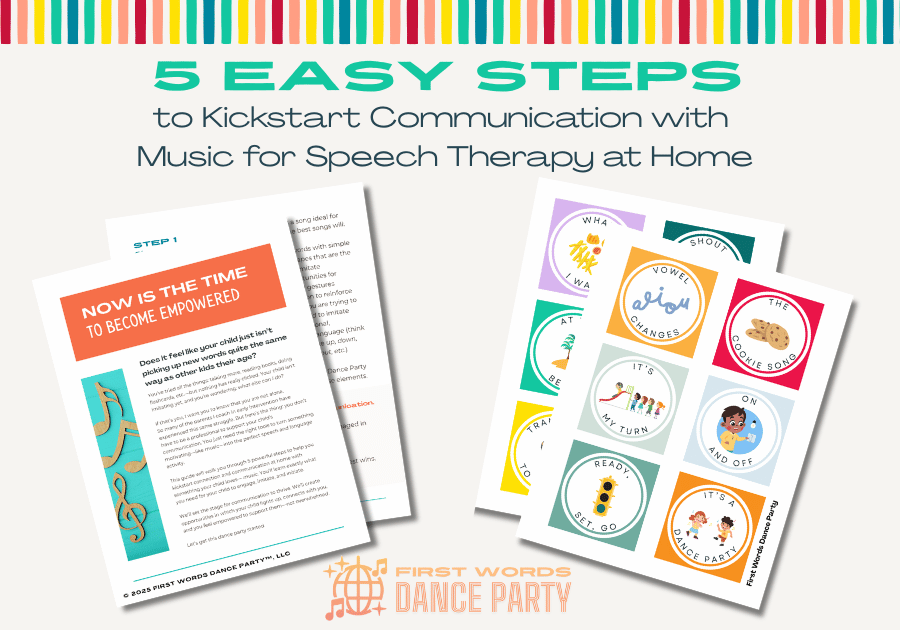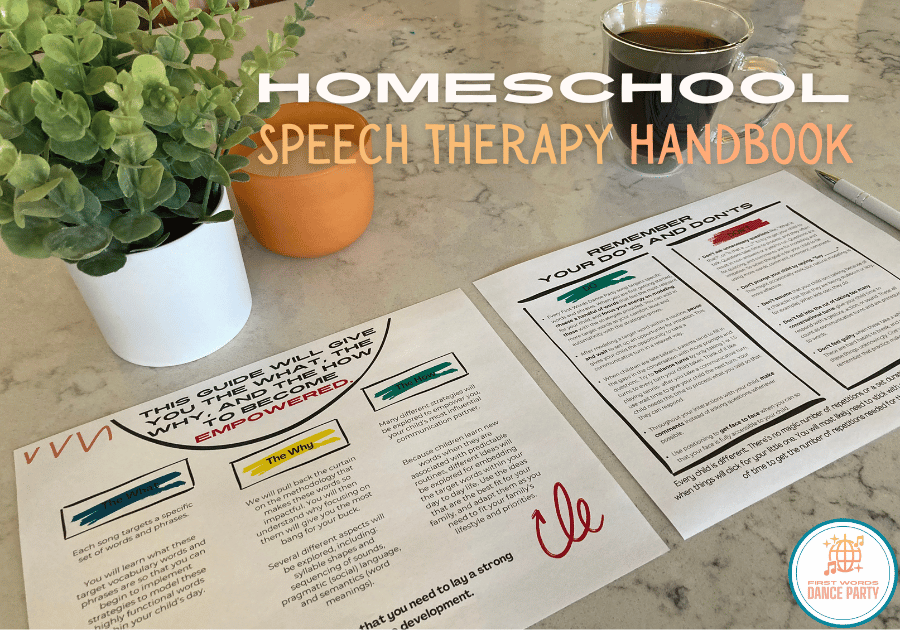Speech Therapy Home Practice: 7 Quick, Easy Activities You Need for Success
- 0 comments
Speech therapy home practice can feel overwhelming—especially when you’re not sure where to start.
As an early intervention parent coach, most parents I work with are eager to support their child’s communication, but they don’t always feel confident about how at first. One of the most common questions I get from parents is what kinds of flashcards, apps, or tools they should buy.
So many families are surprised to discover that the best tools for helping their child with their speech delay are already in their home.
Speech therapy home practice doesn’t require bells and whistles. In fact, the best activities for speech therapy at home are the routines you’re already doing with your child every day.
The real magic is finding something motivating within that routine and using the right strategies to help your child with their speech and language.
So if you’re looking for speech therapy activities for toddlers at home, you’ve come to the right place! I’ll share with you my absolute favorites that have worked time and time again.
👉 Does your child love music? As an early intervention teacher, I’ve never once met a child with a speech delay who doesn’t. So I started writing music for speech therapy that weaves in the strategies we use everyday in early intervention. I created First Words Dance Party® as a way for parents to support language through speech therapy songs kids love.
You can download a free guide to discover 5 easy, parent-friendly steps to use music for speech therapy at home to spark connection and communication with your child. As a bonus, you’ll receive song boards with cards for every First Words Dance Party® song, so your child can make choices and discover the power of their voice.
Let’s get into approaches that work and ones that fall flat for speech therapy home practice.
Why Some Approaches Just Don’t Work
When your child is behind in their speech and language, it’s natural to want to do something to help. But not all approaches to speech practice at home are a good fit—especially for toddlers and preschoolers with language delays.
Flashcards, for example, might seem productive, but they usually don’t work for toddlers and preschoolers with speech delays. The problem with flashcards and “educational” toys that talk (yes- even the ones marketed for speech) are that they don’t replicate how actual communication works.
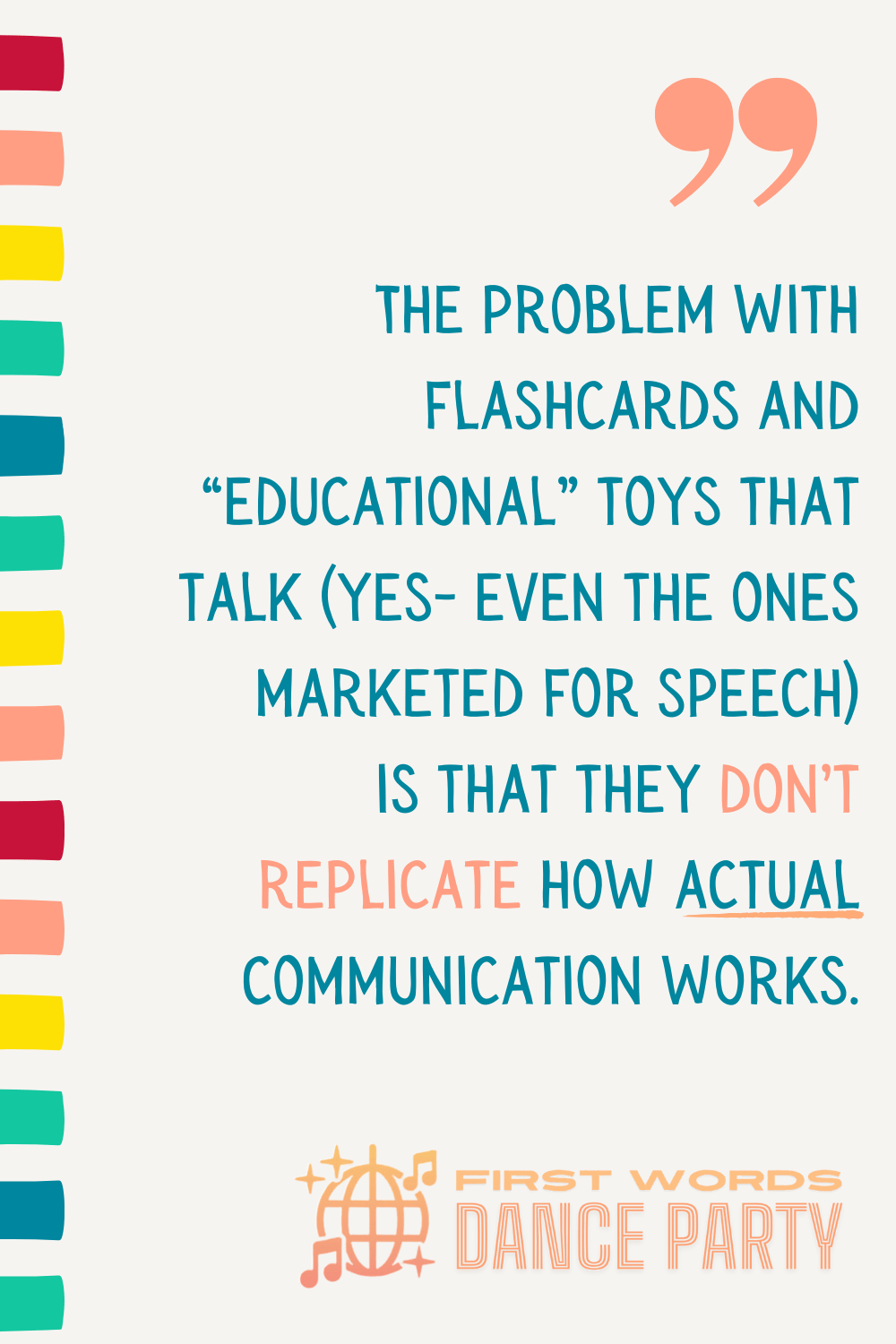
Communication is a back-and-forth exchange. For little ones with language delays, these types of things just can’t provide the same beneficial language models as a parent or speech-language pathologist engaging with the child within a motivating, predictable routine.
The best approaches prioritize teaching a child how to initiate
Children with speech delays often need to learn how to initiate. The problem is that activities that prompt a child too much (e.g., “What is this?”, “What color is it?”, or “Say ___”) can backfire —leading to frustration and creating a habit where the child waits for an adult to initiate first.
And while some home programs may offer a homeschool speech curriculum, speech therapy approaches are not one-size-fits-all. Just like other forms of therapy and education, speech therapy has to be individualized to the skillset of the child. Every child’s needs, interests, and learning style are different, so their speech therapy home program must reflect this.
Another common misstep? Expecting long periods of focused practice. Young children have short attention spans and are constantly shifting between ideas, objects, and activities. Instead of trying to force them to stay on one task, it’s far more effective to follow their attentional focus.
That simply means noticing what your child is interested in the moment and using that moment as a springboard for modeling language. When we talk about what they care about, we create natural motivation and more meaningful opportunities to learn.

That’s why the best speech therapy home practice starts with engagement. It meets your child where they are and builds on their strengths—through play, routines, and everyday moments that are already part of your day.
And with that, let’s dive into seven of the easiest activities for speech therapy home practice. These will give you a starting point—with examples, favorite tools, and the kinds of words you can model as you go.
1. Books are the simplest tools for speech therapy at home
Books can be powerful tools for building your child’s language—but that doesn’t mean you need to sit and read every word on every page. In fact, when it comes to speech therapy home practice, the best way to use books is to follow your child’s lead, especially if they don’t sit for long.
Instead of reading the story word-for-word, try this:
Naming pictures as you point to them or as your child touches them
Modeling gestures (e.g., blowing a kiss, waving) toward the characters in the book
Modeling simple sounds the pictures make (like animal sounds, vehicle sounds, etc.)
Interactive books with flaps, textures, or real-life photos can really capture a child's attention. Plus, lift-the-flap books offer more opportunities to model words for actions (like open, close, and peek), and gestures like knocking.
Check out Little Book League to subscribe for a monthly box of books specific to your child's age. These books are hand chosen by speech and language experts, who take great care to include only the best books for language.
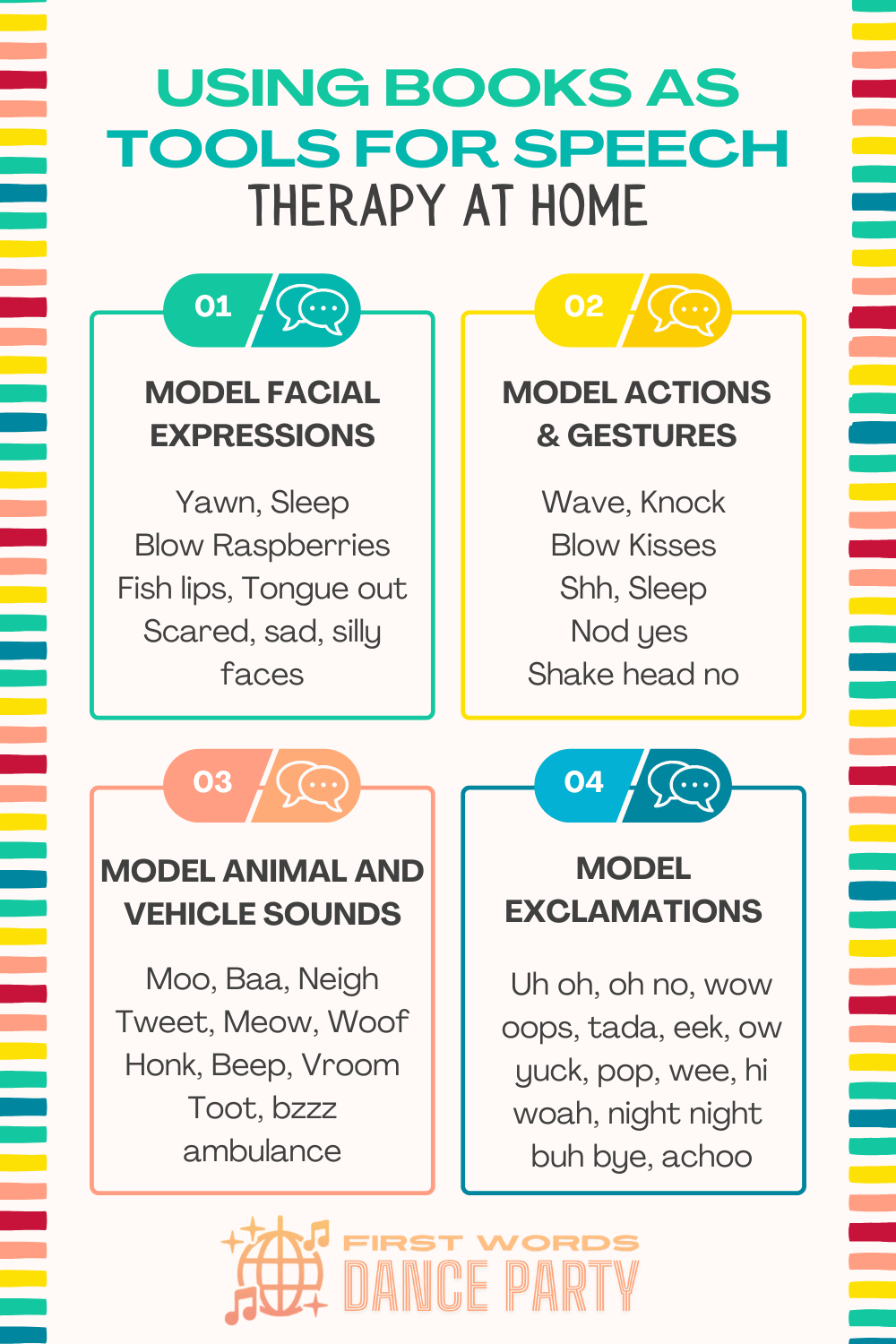
2. Leverage play for speech therapy practice at home
Play is one of the most effective ways to support speech and language at home. When your child is engaged with a toy they love, they’re already primed for communication. Follow their lead, join in, and model language that matches what they are doing.
The best way to do this is by using parallel talk and self-talk, not by asking your child questions. Questions like, "Is your doggie eating?" are for quizzing. When you use parallel talk to comment on what your child is doing, with statements like, "Your doggie is eating"- you are teaching.
For more on those highly effective strategies and others to use for speech therapy at home, you can check out this article:
Delay in Speech? 5 Easy and Effective Ways to Boost Language
Here are a few of my absolute favorite toys for speech therapy home practice, broken down by type:
Farm toys & animals are a goldmine for speech therapy activities at home
There is just nothing as magical as barn animals for working on beginning syllable shapes. Many animal sounds are consonant-vowel (CV), like baa, moo, and neigh. This is important, because CV words are some of the easiest to imitate for late talkers.
Animals are also fantastic for modeling early verbs, or actions words, like eat, sleep, go, wash, walk, etc. When you sit alongside your child and show them how to play pretend with these animals, you are doing wonders for their speech and language.
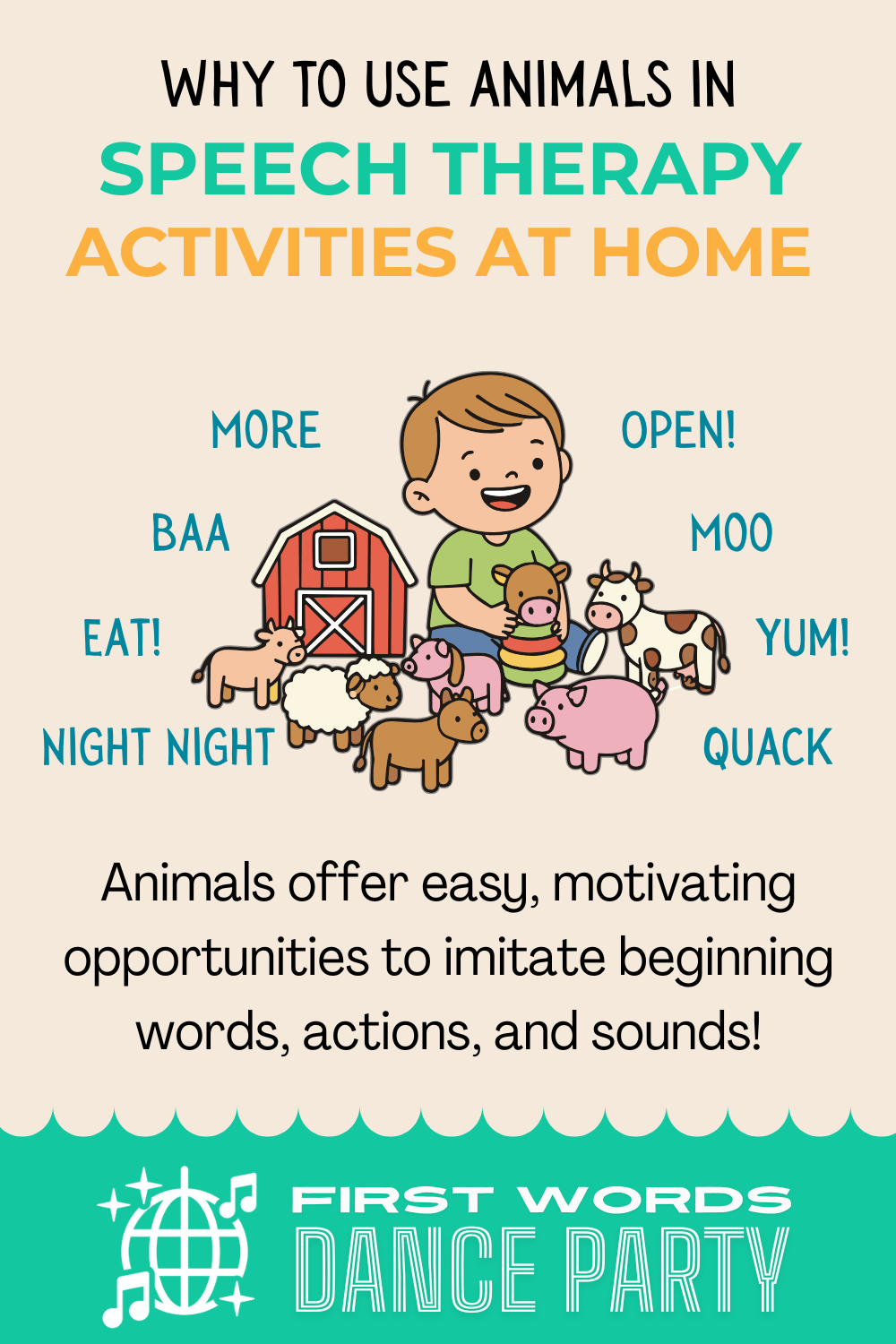
Babies, Stuffed Animals, and Characters
These are another goldmine for modeling pretend play with familiar actions, like eating, sleeping, cooking, and taking a bath. They are also wonderful for modeling simple action words.
Your child may benefit from you showing them different ways to play with their babies and stuffed animals. Try using a couple of different toys together, like putting the baby doll in the back of your child's truck. Now you have even more language opportunities to model words like: woah, fast, bump!, out, crash, uh-oh, etc.
Mr. Potato Head
This classic toy is worth its weight in gold for any parent wanting to support their child's speech and language at home. It's hard to come up with another toy that offers so many opportunities to identify and label body parts.
It also offers natural opportunities for the preposition words in, out, on, and off. An added bonus of this toy is that it’s an awesome two-handed activity for fine motor skills.
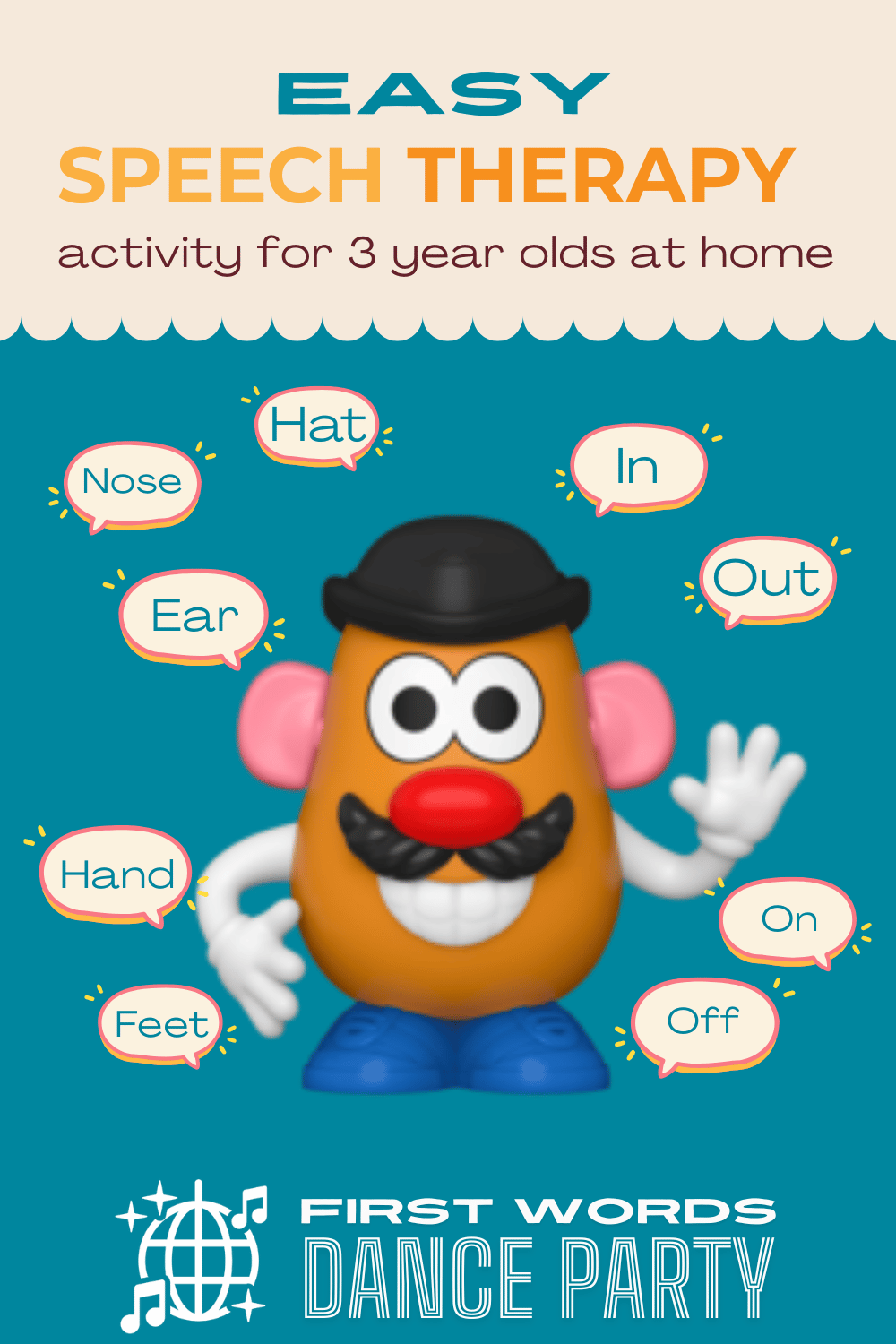
Blocks and construction toys can be used for homeschool speech therapy
These toys are fantastic for action words (stack, crash), descriptors (big, small, short, tall), and spatial words (up, down, behind, on)
Blocks, Legos®, and Magnetiles® are open-ended and grow nicely with a child as they age. While they may only stack and crash now, in a few months, you might make a house or a bed for a doll or action figure.
These are toys you very likely already have on hand for math and science if you are homeschooling.
Construction materials are perfect for turn taking- which can be a hard skill for little ones with speech delays. Your child can naturally take turns with you as you add blocks one at a time to a tower.
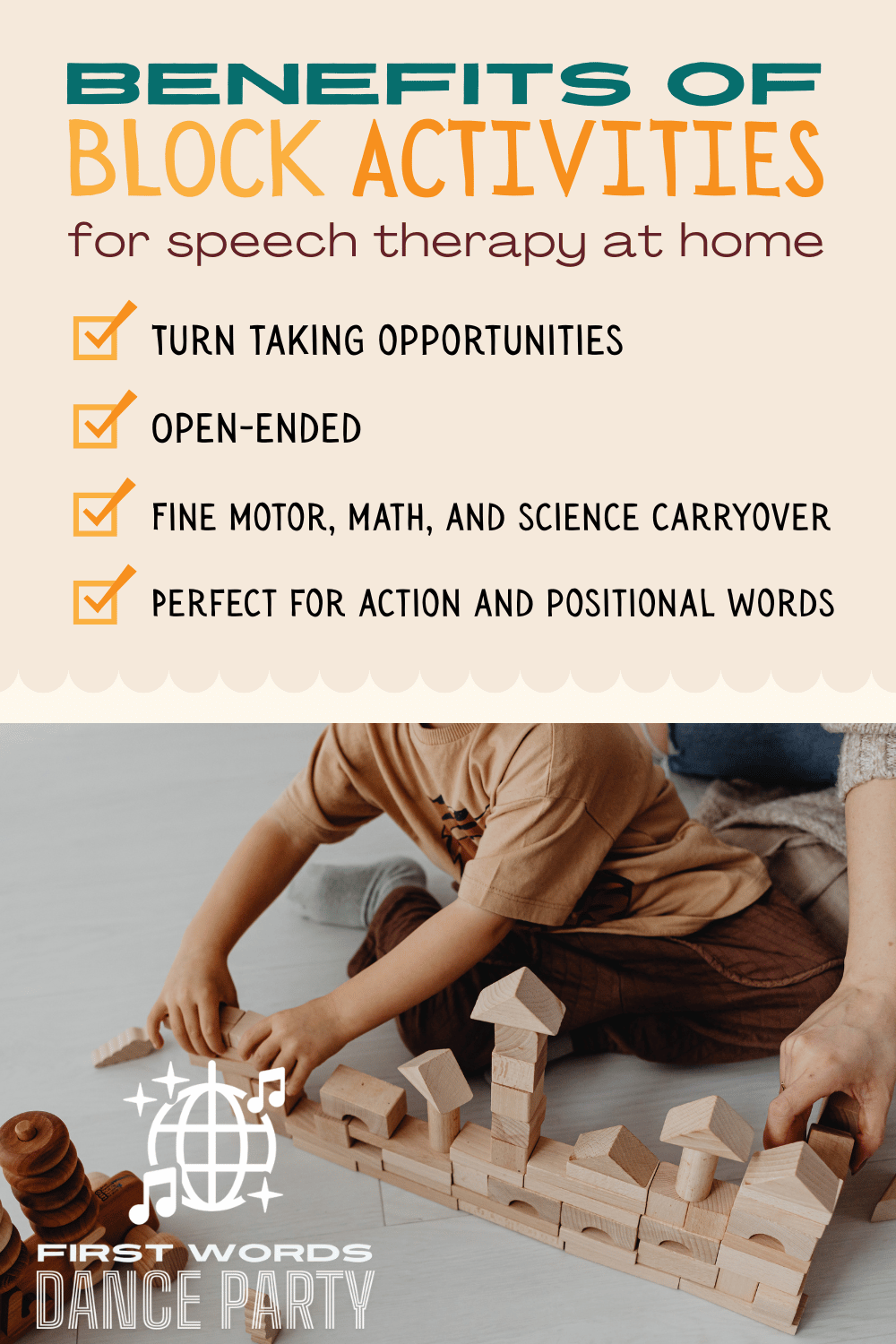
3. Snacks and meals are excellent activities for speech therapy at home
Snack and mealtime routines are golden opportunities for speech therapy home practice. Why? Because they’re naturally motivating, happen multiple times a day, and are filled with chances to model meaningful, functional language.
Try turning these everyday moments into little communication opportunities by:
Offering choices: “Cracker or banana?”
Modeling core words, like: more, want, eat, all done, open, please, and then pausing
Using sign language for those same words to support multimodal communication
You can also create what speech therapists call communication temptations—intentional pauses or natural barriers that create a reason for the child to communicate. For example: Give just a few pieces at a time so they have a reason to ask for “more”
Put their drink nearby but just out of reach so they can point, sign, or vocalize to request it.
For more on how to create natural communication temptations in your child's day, check out this helpful handout from Child Development Programs.

4. Coloring and sensory play are awesome at home speech therapy activities
Coloring, play dough, and sensory bins don’t just hold a child’s attention—they also provide rich opportunities to model language while your child’s hands (and mind) are engaged.
These kinds of activities are perfect for modeling all kinds of actions words and descriptive words, like soft, cold, squishy, wet, etc.
If your child doesn’t engage in much play with toys yet, sensory activities are a perfect activity to get your child started with exploring fluid materials.
Here are a few of my favorite sensory ideas:
Kinetic sand
Play dough (store-bought or homemade)
Rice or bean bins with small objects inside like gems or plastic animals. You can easily create your own sensory bins with items from the dollar store.
Pre-made sensory kits (these are often themed after things like mermaids, dinosaurs, outer space)
Hot tip: Want to spend less time cleaning up? Spread a large towel or blanket underneath your child’s play area so cleanup is quick and stress-free. This makes it easier to say yes to more sensory exploration—and more opportunities for language!

5. Trips to the park make for excellent speech therapy at home activities
Sometimes the best place to support language is outside, where your child can move and engage their whole body. Movement is emotionally regulating, and kids have to be regulated to communicate. That is why outdoor play is the perfect activity for speech therapy at home.
There are so many opportunities to model motivating action words, like: go, stop, jump, run, swing, and push during this time when your child is actively engaged.
Some great outdoor tools for language-rich play:
Bubbles: pop, more, open, blow
Ballplay: rolling a ball back and forth is perfect for turn taking (use it as a communication temptation when you pause and wait)
Slides: up, down, go, more, fast, wee!
Swings: up, push, more, all done, down, go
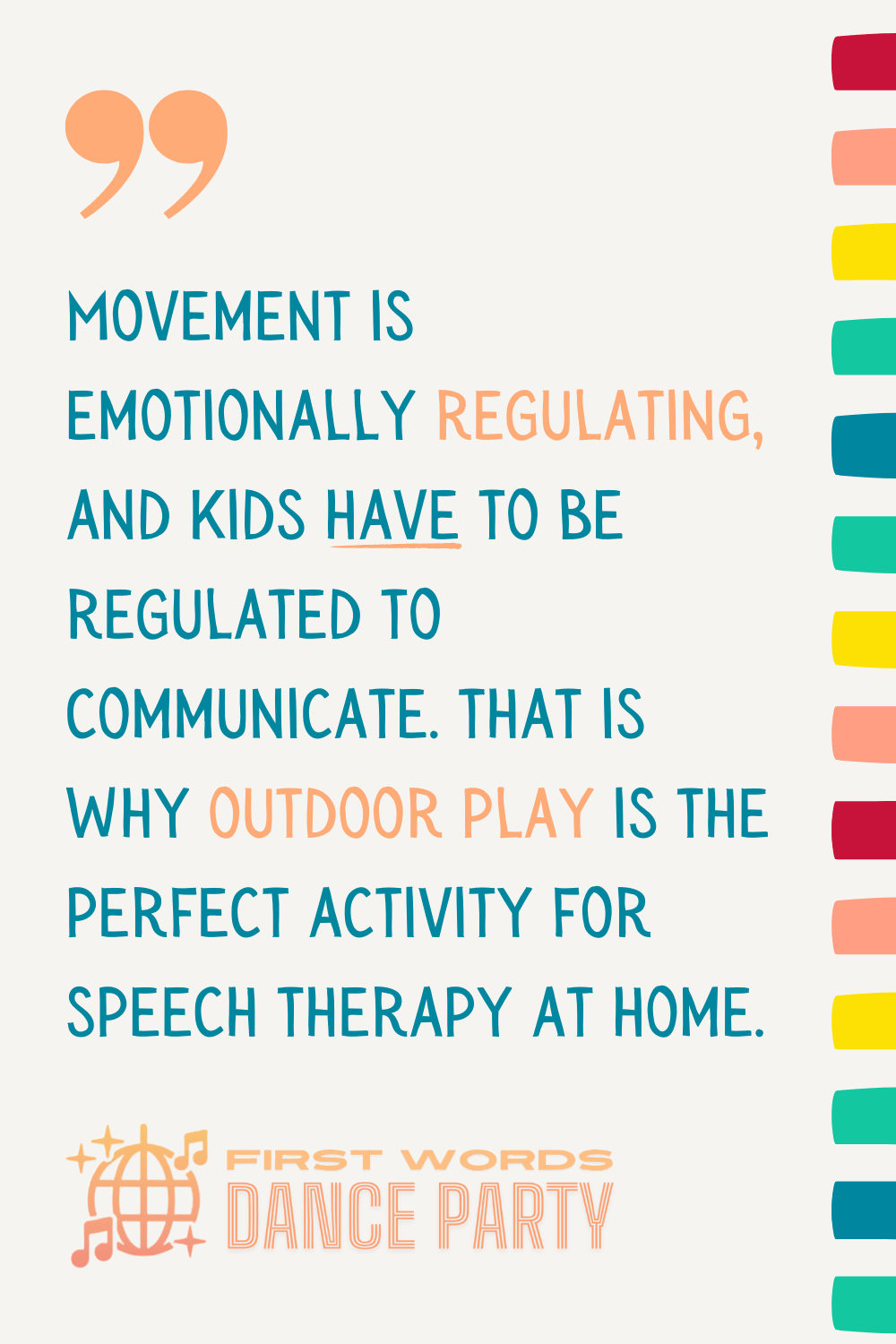
6. Bath time
Bath time is a natural opportunity for face-to-face connection, joint attention, and rich language modeling. It’s the perfect time to take advantage of your child being happily contained in one place for speech and language practice that doesn’t feel like practice at all.
Here are a few ways to turn bath time into a speech-boosting activity:
Model body parts
Use action words: pour, splash, wash, scoop, go
-
Introduce early pretend play by bringing in fun, unexpected toys like:
A plastic baby doll (to wash and dry)
A teaset (for pouring, “drinking,” and making hot cocoa, coffee, and bubble tea)
Sing! This is a perfect time, because you have your child’s attention and the positioning is perfect for face to face interaction.
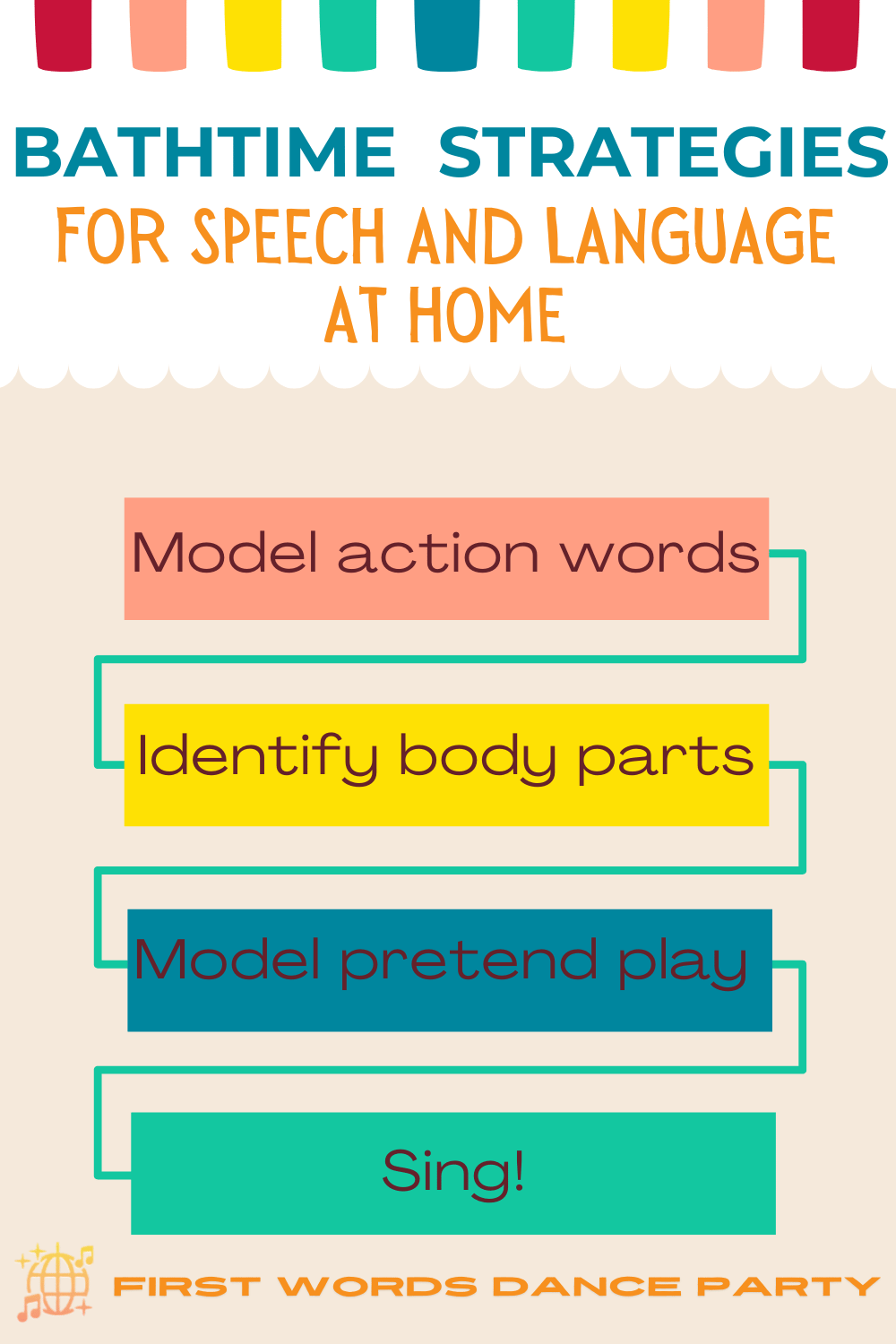
7. Music is an easy win for speech and language at home
Music is one of the most powerful tools we have for speech therapy home practice. It’s engaging, predictable, motivating, and naturally repetitive—essential elements that help young children process and produce language more easily.
Research shows that music and language share overlapping areas in the brain. The rhythm, repetition, and melody of songs help children process and remember language, while also building engagement and shared joy.
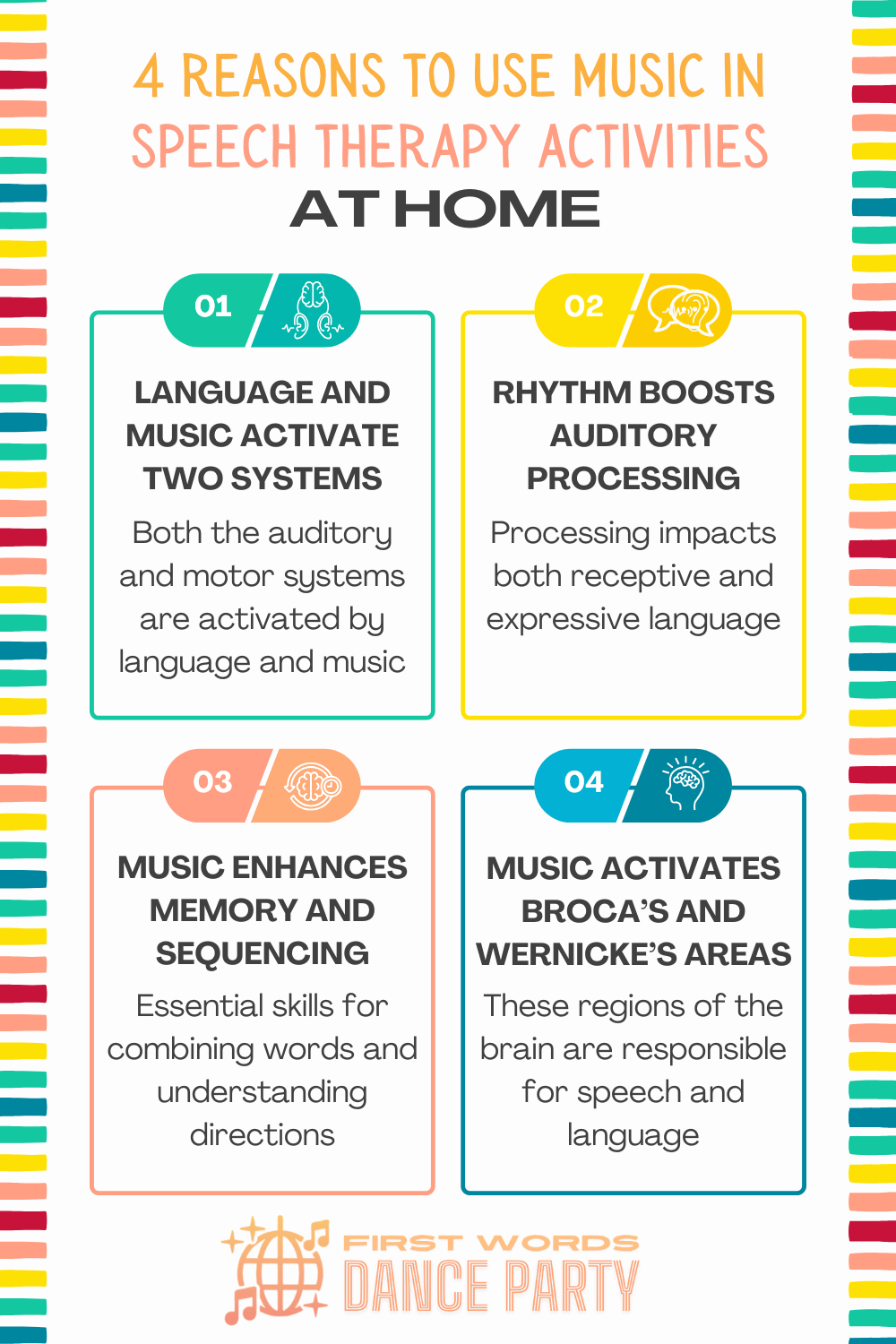
That’s exactly why I created First Words Dance Party®, fun, catchy, original songs written specifically to support early communication for children with speech delays. Each lyric is crafted with speech and language strategies behind it, giving parents a simple, engaging way to encourage language.
First Words Dance Party® makes speech therapy home practice fun!
These songs were born out of my work in early intervention—they’re designed to be both fun and functional. You’ll hear phrases like “help me,” “shoes on,” “my turn,” and “open please”—the kinds of words that carry over seamlessly into real life. And they’re fun and easy on the ears, so you’ll enjoy listening and singing along.
Here are a few examples:
The Cookie Song: This kid favorite targets the core words yes and no, along with the words eat, want, what, doggie, and of course, cookie! This one is perfect for kids who aren’t yet gesturing or saying yes and no.
Ready, Set, Go: This one uses a powerful strategy, called an anticipatory set, to promote engagement. It targets the opposite pair stop and go, along with the words push, pull, bubbles, uh-oh, oh no, more, and I.
It’s a Dance Party: Another kid favorite, this one teaches the names of body parts- llke eyes, nose, ears, hands, and feet. It also targets the words up and down, with plenty of functional examples in the lyrics (like clean up, pick me up, get down, slide down, etc.)
You can stream First Words Dance Party® on Spotify, YouTube Music, Apple Music, and anywhere else you get your music.
These speech therapy songs and resources were created to give parents an easy, joyful way to model language at home—no waiting lists, no flashcards, no pressure. Just real connection and steady growth through music that brings you and your child together.
Gain confidence and a clear plan with the Speech Therapy Homeschool Handbook
If you’re navigating speech delays at home, it’s easy to feel lost. You want to support your child’s communication—but you don’t know what to do for speech therapy at home.
You’re not alone—and you don’t need to be a trained therapist to make a meaningful difference.
Whether you're homeschooling full-time or simply just looking for a meaningful way to support your child's speech and language, this handbook offers a gentle starting point for homeschool speech therapy.
You’ll learn what strategies work best for speech delays, why they’re effective, and how to do speech therapy at home through everyday moments—like snack time, bath time, and getting dressed. With simple, repeatable speech therapy at home exercises, you’ll feel confident supporting your child’s communication without worksheets or overwhelm.
Final thoughts on speech therapy home practice
Speech therapy home practice isn’t about adding drills, flashcards, exercises, and additional activities into your day. The best activities for speech therapy practice at home are the routines of your child’s day.
You don't have to have a degree or a certificate to get your little one talking- just a willingness to learn.
Ready to trade the tears and frustration for smiles, giggles, and communication growth? Don’t forget to grab your FREE 5 Easy Steps to Kickstart Communication with Music for Speech Therapy at Home.
It’s time for your child to discover the power of their voice. Imagine the feeling when your child sings a new word they’ve never said before or points to a picture of their favorite song to make a choice. You can make those meaningful changes happen when you start using music for speech therapy at home!
I hope this article has helped you gain some fresh ideas and resources for meaningful speech therapy home practice with your little one.
FAQ: Speech Therapy at Home
How can my child get one-on-one speech therapy at home with a speech therapist?
If you’re interested in having your child work one-on-one with a speech-language pathologist at your home, there are many organizations that provide it. The process would start with an evaluation to gather information on your child’s current strengths and needs, and then services would start after that.
These services typically go through your insurance, although some providers also accept private pay (i.e., paying out of pocket).
What are some easy speech therapy activities at home?
The best speech therapy activities at home should include something that your child finds motivating. They also should give you multiple opportunities to model a few target words. Your child is most likely to be actively engaged during an activity that they find motivating, and when children are actively engaged, they are better able to pick up language.
Some of the easiest, most highly motivating activities to get your started with your speech therapy home program could include:
Blowing bubbles
Play Dough, slime, sand, or other sensory play
Water play
Singing favorite songs with gestures and actions
Physical play (like being tossed in the air, onto a couch, or being pushed in a laundry basket)
Do I need a speech therapy homeschool curriculum to practice speech at home?
You don’t need a homeschool speech curriculum for meaningful practice at home, especially if your child a toddler or preschooler. The best activities for speech therapy for this age are play-based or routines-based, because these are the things that hold a young child’s attention.
That said, many parents need clarity and structure to help make sense of what to do during these activities to help their child talk more. The Speech Therapy Homeschool Handbook is a great option if you’re looking for an easy, parent-friendly plan to guide you through what to focus on during these activities to get your child imitating words.
This handbook works especially well for children and parents who are music-lovers, because the guide is structured around First Words Dance Party® speech therapy songs. When you listen to the songs with your child, and then use the Handbook, you’ll know exactly what activities and strategies to use to help your child with the words and phrases within the corresponding song.
How can First Words Dance Party® help with speech and language at home?
Many families find music-based routines to be a powerful part of their speech therapy home practice. Every song by First Words Dance Party® uses speech therapy strategies within the lyrics to help children learn and imitate functional words and phrases. And the best part is that listening and singing along together with your child never feels like work or drilling.
There couldn't be an easier activity for speech therapy home practice!
